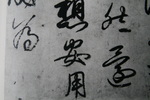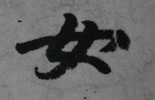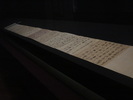 In 1899, at Anyo in China, there was a big excavation.
In 1899, at Anyo in China, there was a big excavation.They were relics of Yin dynasty (BC.1500-1100).
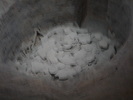 We can see many shells of tortoise at the museum at Anyo.
We can see many shells of tortoise at the museum at Anyo.
 We can see a script "woman" on the shell of tortoise. We call one of the scripts "Kokotsu-bun". Kokotsu means the shell of a tortoise or the bone of an ox.
We can see a script "woman" on the shell of tortoise. We call one of the scripts "Kokotsu-bun". Kokotsu means the shell of a tortoise or the bone of an ox.
 At Anyo, many bronze vessels were also found in the ground.
At Anyo, many bronze vessels were also found in the ground. We can see some scripts inside the bronze vessels. We call them "Kin-bun."

 You can see another vessel and the script "woman". It means "a woman squats herself down with her hands crossed."
You can see another vessel and the script "woman". It means "a woman squats herself down with her hands crossed."
 The researchers of "Kin-bun" made the year of making each bronze clear. This is the most famous vessel,"Daiutei." It was made in Zhous dynasty (BC. 1100-300)
The researchers of "Kin-bun" made the year of making each bronze clear. This is the most famous vessel,"Daiutei." It was made in Zhous dynasty (BC. 1100-300)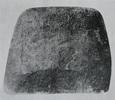
 This is the oldest stone on which Tensho was ngraved(BC.374).
This is the oldest stone on which Tensho was ngraved(BC.374).Near Qin dynasty (late Zhous dynasty). Kin-bun became a little different from the early one. We call this style of the script "Tensho". It looks rather tidy and neat.
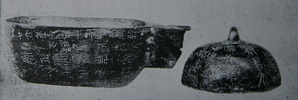 These are the vessels made of bronze or iron in Qin dynasty (BC.220-200). You can see the script "woman". Its vertical line leans to the left.
These are the vessels made of bronze or iron in Qin dynasty (BC.220-200). You can see the script "woman". Its vertical line leans to the left.
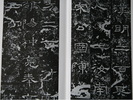
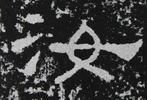 At Han dynasty (BC. 206-AD.220) in China, the style of the script changed. The vertical center line changed to horizontal, oblong style to wide. We call this style "Reisho".
At Han dynasty (BC. 206-AD.220) in China, the style of the script changed. The vertical center line changed to horizontal, oblong style to wide. We call this style "Reisho".We can see many monuments in Reisho in China.
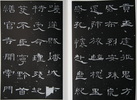
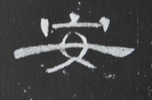
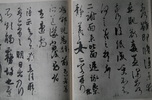
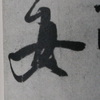
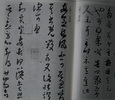
 After Han dynasty, in southern part of China, paper
became prevalent. The style of the scripts on paper changed again. We call the upper one "Gyosho", the lower one "Sosho"
After Han dynasty, in southern part of China, paper
became prevalent. The style of the scripts on paper changed again. We call the upper one "Gyosho", the lower one "Sosho"
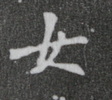 At northern part of China, there were many records of
deceased persons' names and lives inscribed on tombstones. We call this style of script on tombstones "Kaisho".
At northern part of China, there were many records of
deceased persons' names and lives inscribed on tombstones. We call this style of script on tombstones "Kaisho".
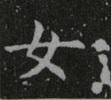 There were many beautiful scripts in Sosho, Gyosho, and Kaisho, in Tang dynasty (AD.618-907).
There were many beautiful scripts in Sosho, Gyosho, and Kaisho, in Tang dynasty (AD.618-907). Let me introduce some representative printing. This is Kaisho.

 This is Kaisho, too.
This is Kaisho, too.
 This is Sosho. The lower part is the script "woman."
This is Sosho. The lower part is the script "woman."Three styles of the scripts, that is, Kaisho, Gyosho, and Sosho were completed in Tang dynasty in China.
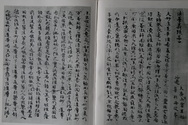 This is the oldest writing in Japan by Shotoku-taishi.(AD.615).
This is the oldest writing in Japan by Shotoku-taishi.(AD.615).For 600-800 years. many styles of writing, that is, Tensho, Reisho, Kaisho, Gyosho, and Sosho came into Japan from China.
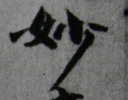
Early Heian age (AD.794-1000) letters or poems were written in Gyosho or Sosho.
You can see the script "woman" written by famous writers in Japan.
This is Gyosho by Tofu Ono.
